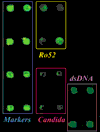Autoantibody profiling for the study and treatment of autoimmune disease
- PMID: 12223102
- PMCID: PMC128938
- DOI: 10.1186/ar426
Autoantibody profiling for the study and treatment of autoimmune disease
Abstract
Proteomics technologies enable profiling of autoantibody responses using biological fluids derived from patients with autoimmune disease. They provide a powerful tool to characterize autoreactive B-cell responses in diseases including rheumatoid arthritis, multiple sclerosis, autoimmune diabetes, and systemic lupus erythematosus. Autoantibody profiling may serve purposes including classification of individual patients and subsets of patients based on their 'autoantibody fingerprint', examination of epitope spreading and antibody isotype usage, discovery and characterization of candidate autoantigens, and tailoring antigen-specific therapy. In the coming decades, proteomics technologies will broaden our understanding of the underlying mechanisms of and will further our ability to diagnose, prognosticate and treat autoimmune disease.
Figures

Similar articles
-
Protein and peptide array analysis of autoimmune disease.Biotechniques. 2002 Dec;Suppl:66-9. Biotechniques. 2002. PMID: 12514932 Review.
-
Millennium Award. Proteomics for the development of DNA tolerizing vaccines to treat autoimmune disease.Clin Immunol. 2002 Apr;103(1):7-12. doi: 10.1006/clim.2002.5185. Clin Immunol. 2002. PMID: 11987980 Review.
-
Protein array autoantibody profiles for insights into systemic lupus erythematosus and incomplete lupus syndromes.Clin Exp Immunol. 2007 Jan;147(1):60-70. doi: 10.1111/j.1365-2249.2006.03251.x. Clin Exp Immunol. 2007. PMID: 17177964 Free PMC article.
-
Array-Based Profiling of Proteins and Autoantibody Repertoires in CSF.Methods Mol Biol. 2019;2044:303-318. doi: 10.1007/978-1-4939-9706-0_19. Methods Mol Biol. 2019. PMID: 31432421
-
[Mechanism of autoantibody production].Rinsho Byori. 2001 Jun;49(6):566-70. Rinsho Byori. 2001. PMID: 11452542 Japanese.
Cited by
-
Multiplexed protein measurement: technologies and applications of protein and antibody arrays.Nat Rev Drug Discov. 2006 Apr;5(4):310-20. doi: 10.1038/nrd2006. Nat Rev Drug Discov. 2006. PMID: 16582876 Free PMC article. Review.
-
Optimization of current and future therapy for autoimmune diseases.Nat Med. 2012 Jan 6;18(1):59-65. doi: 10.1038/nm.2625. Nat Med. 2012. PMID: 22227674 No abstract available.
-
Generation of anti-idiotypic antibodies to detect anti-spacer antibody idiotopes in acute thrombotic thrombocytopenic purpura patients.Haematologica. 2019 Jun;104(6):1268-1276. doi: 10.3324/haematol.2018.205666. Epub 2018 Dec 6. Haematologica. 2019. PMID: 30523052 Free PMC article.
-
Circulating Brain-Reactive Autoantibody Profiles in Military Breachers Exposed to Repetitive Occupational Blast.Int J Mol Sci. 2024 Dec 21;25(24):13683. doi: 10.3390/ijms252413683. Int J Mol Sci. 2024. PMID: 39769446 Free PMC article.
-
A versatile protein microarray platform enabling antibody profiling against denatured proteins.Proteomics Clin Appl. 2013 Jun;7(5-6):378-83. doi: 10.1002/prca.201200062. Epub 2013 May 17. Proteomics Clin Appl. 2013. PMID: 23027520 Free PMC article.
References
-
- James J, Harley J. Linear epitope mapping of an Sm B/B' polypeptide. J Immunol. 1992;148:2074–2079. - PubMed
-
- Ekins RP. Multi-analyte immunoassay. J Pharm Biomed Anal. 1989;7:155–168. - PubMed
-
- Fodor SP, Read JL, Pirrung MC, Stryer L, Lu AT, Solas D. Light-directed, spatially addressable parallel chemical synthesis. Science. 1991;251:767–773. - PubMed
-
- Schena M, Shalon D, Davis RW, Brown PO. Quantitative monitoring of gene expression patterns with a complementary DNA microarray. Science. 1995;270:467–470. - PubMed
Publication types
MeSH terms
Substances
Grants and funding
LinkOut - more resources
Full Text Sources
Other Literature Sources
Medical

